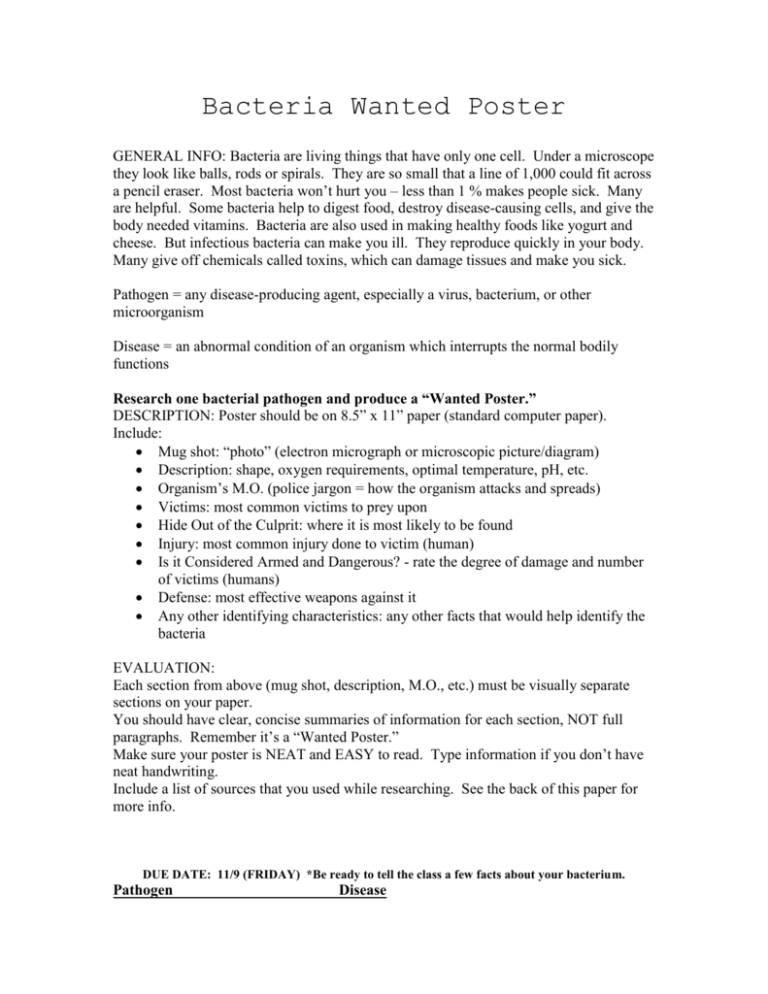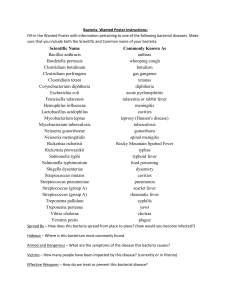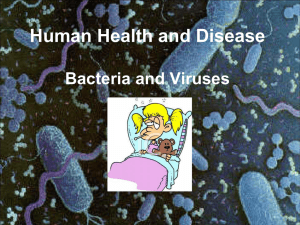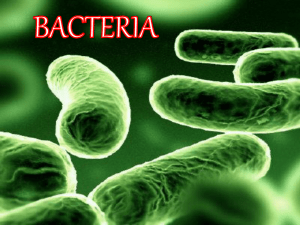Bacteria Wanted Poster GENERAL INFO: Bacteria are living things
advertisement

Bacteria Wanted Poster GENERAL INFO: Bacteria are living things that have only one cell. Under a microscope they look like balls, rods or spirals. They are so small that a line of 1,000 could fit across a pencil eraser. Most bacteria won’t hurt you – less than 1 % makes people sick. Many are helpful. Some bacteria help to digest food, destroy disease-causing cells, and give the body needed vitamins. Bacteria are also used in making healthy foods like yogurt and cheese. But infectious bacteria can make you ill. They reproduce quickly in your body. Many give off chemicals called toxins, which can damage tissues and make you sick. Pathogen = any disease-producing agent, especially a virus, bacterium, or other microorganism Disease = an abnormal condition of an organism which interrupts the normal bodily functions Research one bacterial pathogen and produce a “Wanted Poster.” DESCRIPTION: Poster should be on 8.5” x 11” paper (standard computer paper). Include: Mug shot: “photo” (electron micrograph or microscopic picture/diagram) Description: shape, oxygen requirements, optimal temperature, pH, etc. Organism’s M.O. (police jargon = how the organism attacks and spreads) Victims: most common victims to prey upon Hide Out of the Culprit: where it is most likely to be found Injury: most common injury done to victim (human) Is it Considered Armed and Dangerous? - rate the degree of damage and number of victims (humans) Defense: most effective weapons against it Any other identifying characteristics: any other facts that would help identify the bacteria EVALUATION: Each section from above (mug shot, description, M.O., etc.) must be visually separate sections on your paper. You should have clear, concise summaries of information for each section, NOT full paragraphs. Remember it’s a “Wanted Poster.” Make sure your poster is NEAT and EASY to read. Type information if you don’t have neat handwriting. Include a list of sources that you used while researching. See the back of this paper for more info. DUE DATE: 11/9 (FRIDAY) *Be ready to tell the class a few facts about your bacterium. Pathogen Disease Bacillus anthracis Bordetella pertussis Bordetella burgdorferi Clostridium botulinum Clostridium perfringens Clostridium tetani Corynebacterium diphtheriae Escherichia coli Francisella tularensis Hemophilus influenza Lactobacillus acidophilus Mycobacterium laprae Mycobacterium tuberculosis Neisseria meningitidis Rickettsia richettsii Rickettsia prowazekii Salmonella typhi Salmonella typhimurium Shigella dysenteriae Streptococcus mutans Streptococcus pneumoniae Treponema pertenue Vibrio cholerae Yersinia pestis anthrax whooping cough lyme disease botulism gas gangrene tetanus diphtheria acute pyelonephritis/Traveller’s diarrhea tularemia or rabbit fever meningitis cavities leprosy (Hansen’s disease) tuberculosis spinal meningitis Rocky Mountain Spotted Fever typhus typhoid fever food poisoning dysentery cavities pneumonia yaws cholera plague How to find credible resources It is very, very important that you gather your information from credible sources. A credible source is one that can be trusted with the information posted. Since nearly anyone can publish a web site, information found online can be incorrect. How do you find credible information? 1. Look for site published by universities (often end in .edu), government agencies (often end in .gov), or well known institutions (ex: Mayo Clinic). You can also use online encyclopedias (ex: Britannica), but you often have to pay for access. 2. Look for articles that are sourced. This means they list where they got their information. Are their sources credible? Then it's a safe bet that the information in the article is valid. 3. Look for articles that have actual names attached to them. For example, if there is no author or if the author's name is a username (ex: ilikescience1995), you should reconsider the source. 4. Avoid Wikipedia as a source. I know: you love Wikipedia. So do I! But, anyone can edit the information. You are welcome to use Wikipedia as a starting point. But, don't rely on it as an academic source. If the site makes a claim ex: "20% of Americans are infected each year by this bacteria" and it has a source, go to the source and verify the information. Get the information from the sources. Just make sure the source is valid. Does these steps guarantee you'll find only credible sources? No. But, students have found these guidelines helpful in identifying sites with valid information. If you're unsure, ask your teacher and they'll be able to help you. Keep track of your sources! INCLUDE THIS INFORMATION ON THE BACK OF YOUR WANTED POSTER Write down your sources. You must include: 1. Author 2. Name of site or page 3. Web address (URL) of page 4. Date the page was published or reviewed (if you can't find a publish date, write down the date you accessed it) How to find an image of your bacteria While you read sites about your bacteria, you're likely to find a picture of your bacteria. If you don't, cautiously use Google Images. Not all the image results will be of your bacteria. Also, search for the bacteria, not the disease. If you search for the disease, you'll most likely get pictures of what the disease does to humans, not how the bacteria looks.











